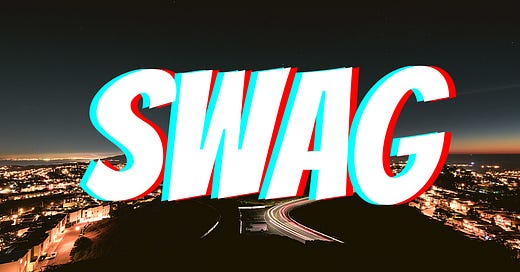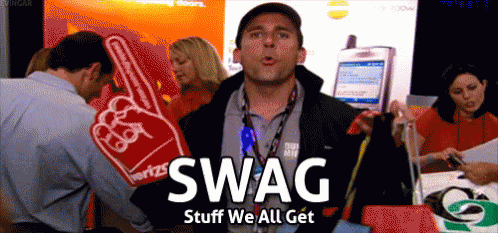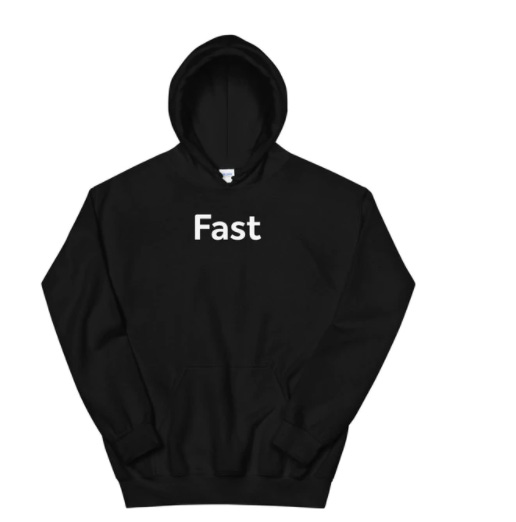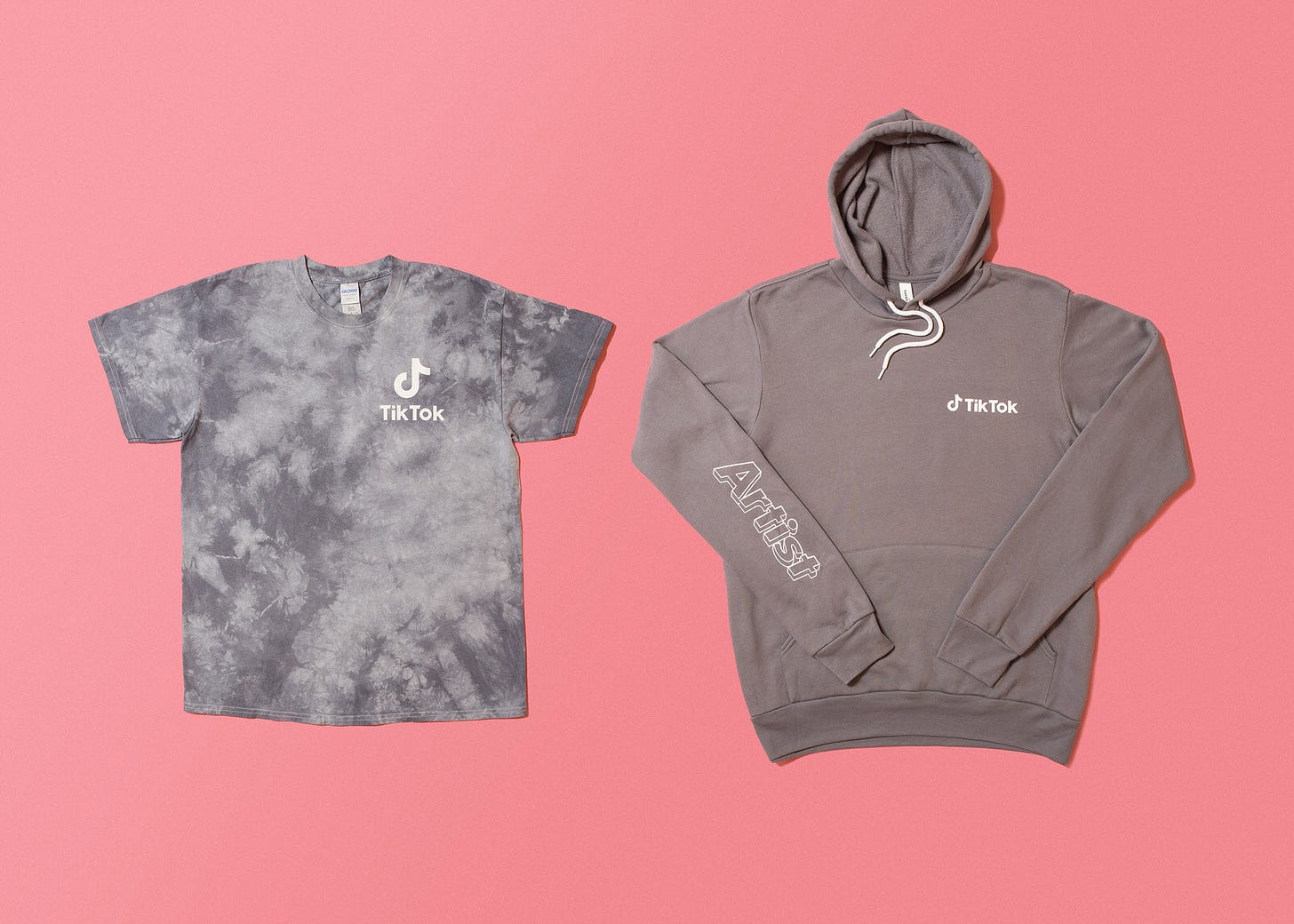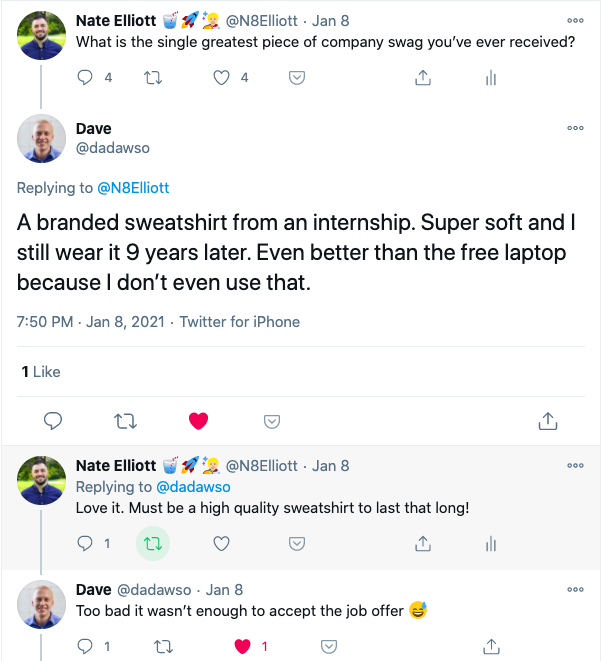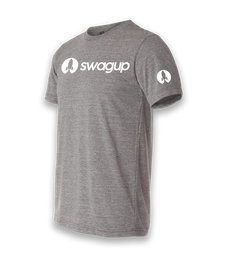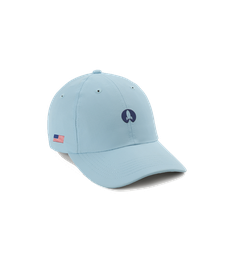Howdy, friends!
Thanks for tuning in to the first-ever issue of Startup Salad, a newsletter about all things startups. I’m excited to offer my first essay, about developing an effective swag strategy. This was really fun because I LOVE SWAG. It’s also 5,000 words… So, the whole issue might not show up in your email. If not, you can read it in your browser here:
I also recorded an audio version for Spotify. You can check that out here:
Now, on to the show!
The Case For Swag
The concept behind “promotional merchandise,” or “swag” is not a new one. In fact, it dates back at least to the distribution of commemorative buttons supporting the election of George Washington in 1789. The real birth of what became the promotional products industry, however, didn’t occur until the late 19th century in a small Ohio town called Coshocton. A newspaper printer had a wild idea to print “Buy Cantwell Shoes” on burlap book bags and then distribute them (for free) to the local school children who visited the printer’s friend, Cantwell’s, shoe store. The plan was wildly successful and soon that printer, Jasper Meeks, was running the very first promotional products company.
And with that, an industry was born.
Over the last 100+ years, swag has become a mainstay in the corporate world. Go to a conference? Get some swag. Salesperson comes to your office? Get some swag. First day at a new job? Definitely gonna get some swag. Even Michael Scott knew (and loved) swag–or in his words Stuff We All Get.
But if everyone already knows about swag, why waste my time writing about it?
Because swag is one of the highest leverage growth mechanisms that your company can employ. Paid ads? Viral tweets? Influencer collabs on TikTok? All good and useful. But I’m talking about plain old branded t-shirts, stickers, hats, and hoodies. If your startup can implement an effective swag strategy, your company will see major growth.
An effective swag strategy is not implemented by accident. It is not simply printing some t-shirts and handing them out. It is an involved process that requires careful thought, planning, and premeditation, because a half-baked swag strategy is an expensive mistake. A flawless swag strategy, however, pays dividends for decades…
So what does an effective swag strategy look like? It’s a recipe with three critical ingredients: beauty, durability, and distribution. It’s like a three-legged stool–without all three legs, it’s no longer a stool. The fact is, if you forget an ingredient in building your swag strategy, you’re going to be frustrated and disappointed, and most importantly your swag strategy will be anything but effective!
Don’t do that. Instead, follow this recipe for doing swag right…
Ingredient #1: beauty.
An effective swag strategy requires high-quality swag, and high-quality swag is beautiful. Beautiful swag is necessary, because you need your customers and employees to actually want to wear/use your swag.
So if you’re making t-shirts, hats, or hoodies, you need to make something fashionable. You need to design a product that people will gladly wear in public–if you don’t, your swag’s purpose won’t be fully fulfilled.
Giving out ugly swag is fine if you only want to build brand loyalty. Remember the scene in Parks and Rec where Leslie and Tom rebrand fluoride as "#Tdazzle" in an attempt to convince the people of Pawnee to let them add fluoride to the reservoir? They show a video, tell them how cool Tdazzle is, and then Tom says something incredibly profound:
"Everyone who tweets @tdazzle in the next hour will be entered to win an exciting plain blue t-shirt."
While at face value, it seems that this was just a silly parody of America's love of free stuff, the audience’s visible excitement at the chance to win "an exciting plain blue t-shirt" reveals an interesting lesson hidden in this scene: people love swag.
So, you can get away with doling out ugly t-shirts and people will still feel a connection with your brand, but ultimately, your swag strategy will be a failure.
Why’s that? Because one of the key purposes of swag is to turn your loyal customers and employees into walking billboards. You wouldn’t pay for a billboard in somebody’s dresser drawer. (And if you did try to pitch your boss on that, you’d probably get fired. Don’t do that.)
Michael Girdley said it best when he said: “T-shirts are amazing ROI. ‘Here's a ten-dollar t-shirt. In exchange, you agree to be a walking billboard for my company. Ok?’”
Every customer grants your brand access to new customers via a highly trustworthy unpaid ad.
You can pay to get your company’s ad on an actual billboard, and you can pay to target potential customers on Facebook, but you can’t pay to have your ad walk into somebody’s house or business with a customer that can vouch for you. A customer wearing your swag is telling those that they come across that you have received their stamp of approval. Anyone who sees your swag can already trust your brand twice as much as they could if they had come across one of your ads, because they have the help of your customer to introduce them to your brand.
It’s a no-brainer: create beautiful swag so that people will wear and use it.
It doesn’t have to be a work of art, it just needs to be beautiful and wearable in public. People will wear anything within the confines of their home, but remember that you want people wearing your billboard in public, and ideally in places where your ideal customers are found. Keep that in mind.
Here’s a quick example of what happens when you create ugly swag, courtesy of one of my all-time favorite television characters, Donald "Jared" Dunn:
If you didn’t watch the video, here’s the takeaway: swag needs to be attractive or people will not wear it (and they might even ridicule you…).
This brings me to my next point: Do not, I repeat, DO NOT screen print your logo onto a $7 plain black or white shirt and call it good. I am begging you.
Now, I’m going to try not to pick on Fast too much in this essay, because they really are doing lots of things right in the swag department, but they are doing one crucial thing wrong: their swag isn’t pretty.
It’s just their company logo screen printed on a hoodie. It’s not good. Now, to be fully transparent, I personally own two of these sweatshirts, but it’s NOT because they’re beautiful, it’s because they were cheap and I’m a sucker for nearly-free (but that’s for later). They’ve created a product people want–because it’s cheap–but that people don’t want to wear. It’s a hoodie you do Saturday morning chores in, not one that you wear shopping. It’s a waste of a billboard!
Good swag, swag that people want to wear, is discrete, elegant, and stylish. It doesn’t rub in your face that it is a promotional product, but instead lets its natural beauty do the talking and subtly reveals its branded nature in its own special way.
Here are some fun examples:
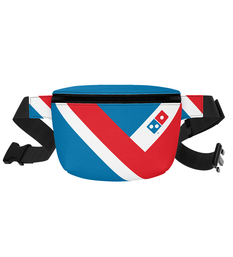
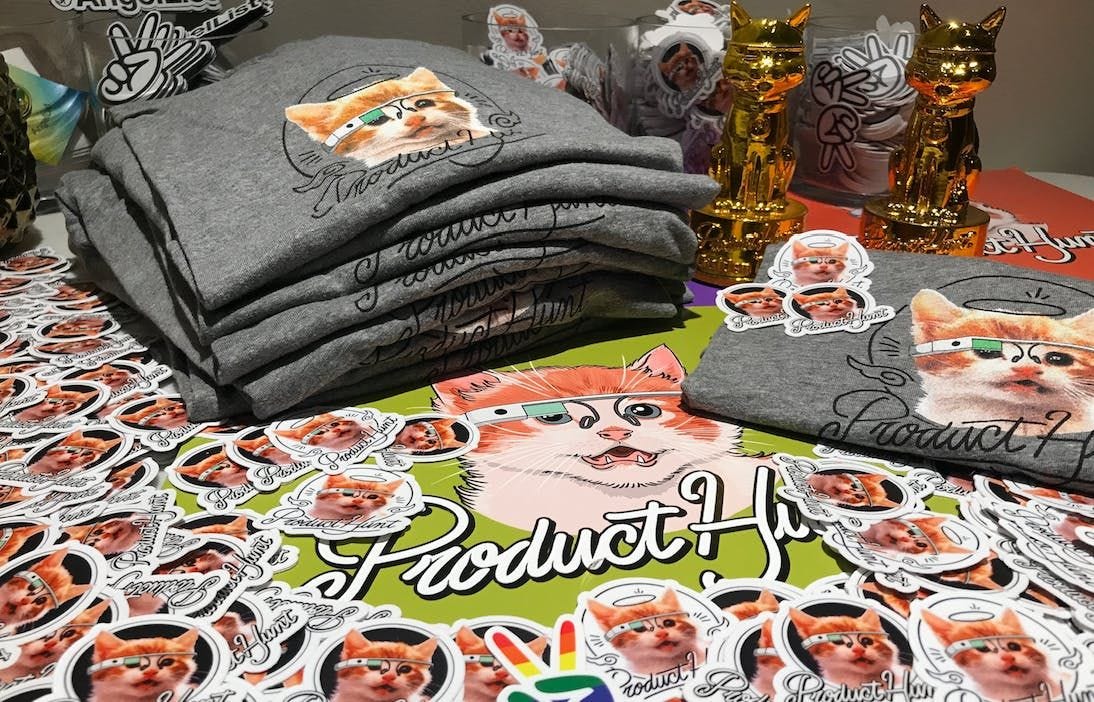
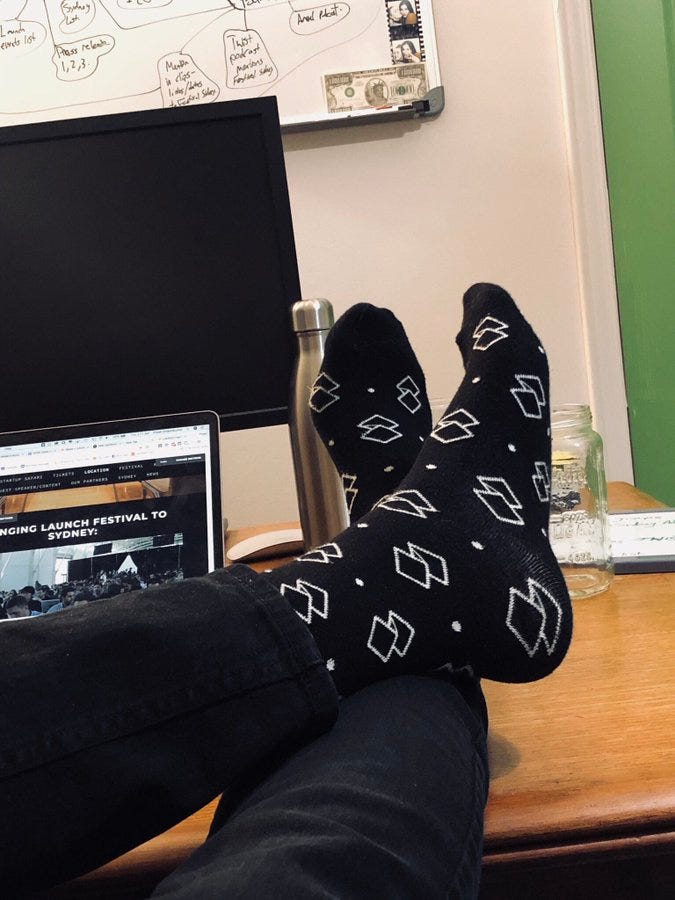
Now, I’ll key you in on a little secret, designing beautiful swag is not easy. Like REALLY not easy. There’s a reason that being a designer is a career. If you’re not “design-inclined,” I’d really recommend finding a professional to help ensure that your swag hits the mark. You really don’t want to order 3,000 ugly t-shirts only to realize that you got the alignment wrong! And if you’re not going to find/hire a designer, please at least read this great article from Joshua Baer, offering some really helpful tips on how to design great swag!
Ingredient #2: durability.
The #1 mistake that businesses make when using t-shirts as a marketing tool, according to Michael Girdley, is buying crappy t-shirts. He’s probably right.
Remember, your swag is a billboard. You have to build your billboard to last the weather.
This tweet, from Sheel Mohnot, provides a good perspective for startup founders questioning why they should invest in durable swag:
“I'm often chatting with other investors while wearing portco swag; it becomes a natural talking point.
Giving investors high-quality swag can have a pretty high ROI”
Swag is a long-term investment in a billboard. When done right, swag can last decades, and that translates into decades worth of exposure and free marketing. When done wrong, swag lasts a few weeks or months or maybe years if you’re lucky. So if you skimp on quality, you’re trading the opportunity for thousands more impressions for a few dollars.
I think this example, from Dave Dawson, is especially enlightening..
Dave didn’t want to work at company X, but he’s been willing to wear their sweatshirt for 9 years. NINE YEARS. For a company he interned for. Talk about ROI.
But, at its core, the case for durability is a simple math problem.
If you spend $5 on a branded t-shirt, you might get 1 year's worth of use. But if you spend $15 on a branded t-shirt, you might get 10 years’ worth of use. Assuming on average your customer wears the shirt in public once per month and sees an average of 25 people each time they wear the shirt, the cost per impression for the $5 shirt is $ 0.017/impression, while the $15 shirt’s is only $0.005/impression. Maybe that doesn’t seem wildly impressive to you, but what that really means is that by giving your customers or team members better swag, you cut your advertising cost by 3x. If you could do that in any other medium, you would, so why not swag?
A final thought on durability, before we move on… We previously mentioned that swag has two purposes: (1) to build loyalty between the company and the recipient of the swag, and (2) to turn the recipient of the swag into a walking, talking brand ambassador and billboard for your company. Don’t overlook the fact that giving away durable, high-quality swag is a display of good faith and care toward the customer or team member to whom you are gifting the swag. If you give cheap swag, you send a message to the giftee that the gesture is completely symbolic–that you don’t actually care enough to give them something they’ll want and use. When you are willing to spend more, you send a better message–that you do care and actually want to do something nice for them.
Don’t give empty gifts.
Ingredient #3: distribution.
Honestly, this might be the most important aspect of a successful swag strategy, and it really just comes down to access.
Because your swag is useless if it isn’t in the hands of the people for whom you made it.
While there isn’t one “right way” to distribute swag, there are three routes that have proven to work well.
The first (and best) strategy I like to call $Free.99.
People love free crap. People will come home from a convention with bags full of free crap they’ll never use. People will go to great inconveniences just to get a free meal on their birthdays or a free product in a giveaway. People love it.
The other day, I legitimately saw somebody on Twitter say the following: “What are the requirements to get one of these?? If I get one I’ll push up my move date by at least a month” The “one of these” that this is in reference to is a T-SHIRT. And you’re going to push up your moving date “by at least a month”??? That’s insane.
Anyway… We know why people love $Free.99, but why does a $Free.99 model work for businesses?!
It’s simple. The $Free.99 strategy, when properly paired with the first two ingredients (beauty and durability) gets products that people want to use/wear, in their hands and on their billboard stands for years and years with as little friction as possible.
No need to worry about finding “the right price” to sell your swag at or about people not finding your webpage to buy your swag. You just give it to them and let it do its thing.
Beyond the seamless placement into the hands of its wearer, gifting swag is also a huge token of appreciation and good faith. When a customer walks into your store or business and leaves with a rad sticker, a branded hat, or a new t-shirt, they also leave with the feeling that they got a good deal. They got a “win” for the day. Think about it. If you aren’t expecting to get a gift, and somebody gives you one–especially if it’s a good one–you’re going to be ecstatic.
You can create this experience for your customers. You can make them excited to tell their friends about you.
But don’t stop there. Do this for your employees too.
On a new employee’s first day of work, plop down a swag basket on their desk. Show them that you appreciate them. Still, don’t stop there. Every few months, give them a small gift (branded of course) and just think of it as a marketing expense. This does the same thing for your employee as it does for the customer, but in a different context. Instead of your employee encouraging their friends to become a customer (which they’ll probably also do), they’ll encourage them to become an employee. This is a huge bargain for you, because we all know how big of a hassle hiring and recruiting can be. If you can build a brand for your company as a place that takes care of its employees and where employees like to work, hiring your next employees will become significantly easier and–more importantly–less expensive.
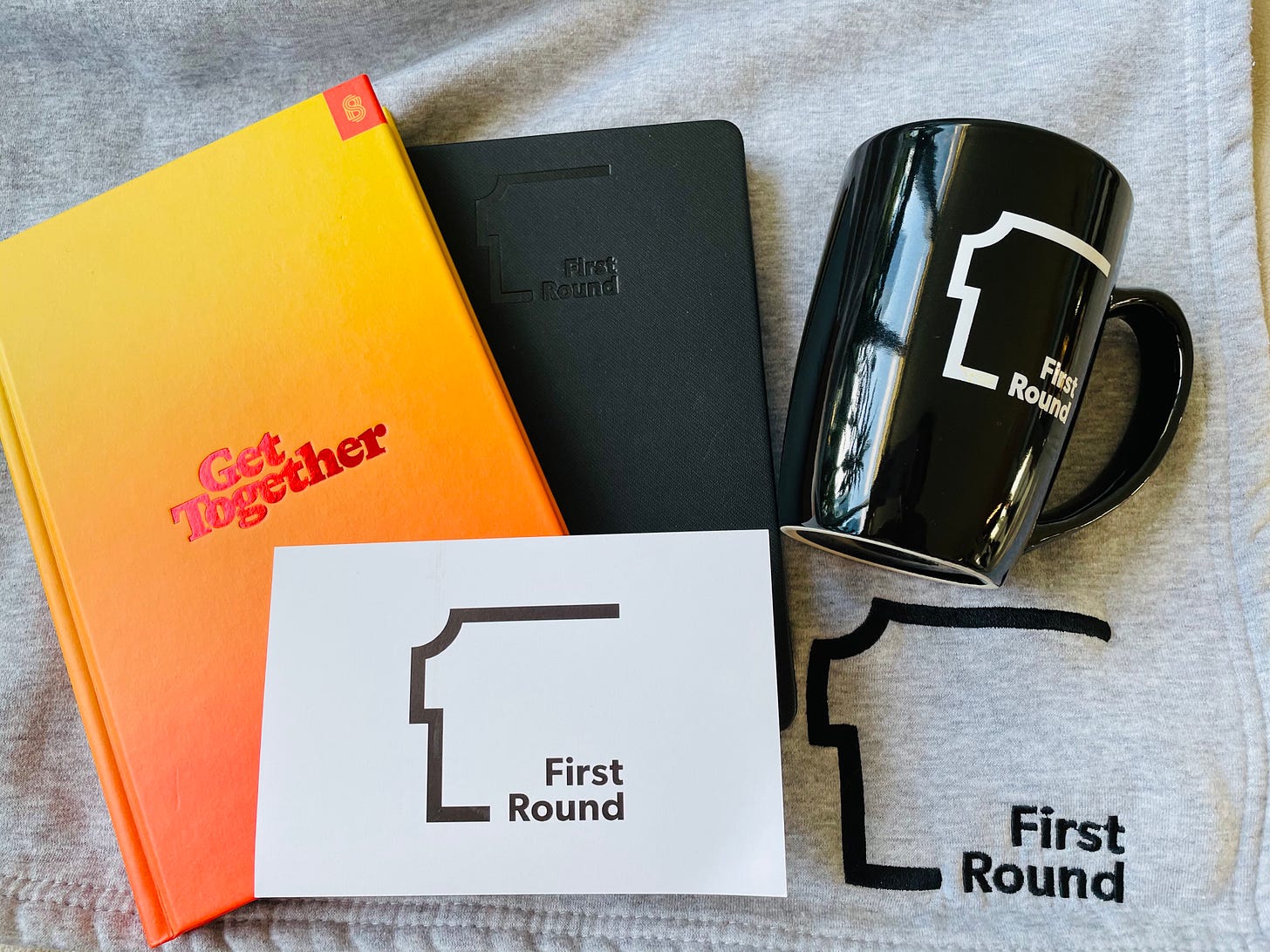
On top of helping recruit employees, decking your current employees out in company swag can also help you retain employees. One study shows that turnover can cost a company $15k per employee. While I’m no mathematician, even I know that dropping a hundred bucks per year on swag for an employee sounds a lot cheaper than the $15k it will cost you to replace them. (But for the record, don’t count on tossing a branded sweatshirt at underpaid, unhappy employees and having them completely change their attitudes. You have to do the basics first and then the swag is icing on the cake.)
Now, it’s my turn to give a quick plug for two companies that have been kind enough to gift me with some swag: CommandE and Public.
CommandE is the world’s coolest productivity tool. Pull up documents, files, calendar invites, emails, and lists with a single keystroke. It’s a huge timesaver, especially when you’re constantly switching between different systems. Instead of going to finder to open a Word doc, I just press command+e and search the file I need. I can also search Google Docs and Notion pages at the same time, all in one place!
Public makes the stock market social. Follow other investors, discover companies to believe in, invest with any amount of money. Think Robinhood, but with your friends. It’s really cool. So cool that I’ve gotten six of my friends to sign up! You can join too and we’ll both get a free slice of stock!
(Clearly, the $Free.99 model is working for Public and CommandE, as I’m telling my friends about it in my newsletter!
The second strategy we’ll call At-Cost or Less.
The At-Cost or Less strategy involves selling swag at-cost or below. Duh. It’s for companies that aren’t trying to make a profit, but also don’t want to foot the bill completely.
This method can work great. In fact, this is where we’ve seen Fast shine. It runs $5 sales for its ugly hoodies and I personally have bought FOUR of them. AND I DON’T EVEN BELIEVE IN THE COMPANY!!!
I just like nearly-free crap. And I’m NOT ALONE.
Fast’s CEO, Domm Holland, is a master hype-builder and ran mini-campaigns where he urged “fastronauts” (it’s a cool name…) to buy sweatshirts during tight windows. I know exactly where they are ordering and printing their hoodies from, because I’ve used the same company to sell clothing. That also means I know that Fast was likely losing around $10 on each hoodie (Domm also confirmed they were selling them below cost).
They sold nearly 10,000 of the aforementioned boring sweatshirts. TEN THOUSAND. Unless they got some huge bulk deal, which I doubt they did, because it appears they were printing them on demand, that means they likely spent close to $100,000 on those hoodies. Insane.
In fact, the Fast CEO even shared a Twitter thread on the subject, explaining “a huge intentional plus of this strategy was that all of these users, also ended up with a branded hoodie, walking around showing our brand off”. Now, I don’t know if Fast will be successful, but I do know that they’ve successfully built a ton of hype around a “one-click checkout” startup, which is pretty wild…
Another personal favorite example of a company that sells its swag, but does so at an affordable price is Shrug Capital.
I love Shrug. Seriously. I wear a Shrug mask and a Shrug shirt, and my laptop is decked out in Shrug stickers. Why do I, a guy living in Spokane, WA, have a bunch of swag for a microVC firm based in San Francisco? Because they make cool crap and either give it away (thanks, Nick!) or sell it for cheap.
They sell their masks for $12 and their t-shirts for $13, and you know what? I will 100% pay for that, and lots of others do too. It’s an awesome marketing strategy. Every year they also do a limited edition tweet calendar, with a tweet for every day of the year. Venture capitalist, Semil Shah called it “the single best piece of VC swag collateral I've seen to date.”
But Shrug doesn’t stop there. They’re also well-known for giving away (i.e. for free) swag packs filled with stickers, tattoos, and socks. Their website is basically a collage of a bunch of awesome people with their swag. That’s why I wear their swag. Because I saw cool people doing it and wanted to be cool. It’s human nature.

And do you want to know how often people ask me what the Shrug symbol on my shirt, phone, laptop, mask, etc. means? ALL THE FREAKING TIME. Seriously. There are tons of people in Spokane, WA who have no idea what venture capital is, but now know about Shrug. Because of me.
Anyway, this strategy definitely works, especially when used in combo with the $Free.99 method.
Plus, you do save some money on cost and you have to deal with fewer freeloaders just looking for free crap. People that are willing to pay at least a little bit are often way less of a pain in the ass than people that just want “free, free, free.”
But please, don’t try to use this method on employees. It’s not going to work well. Employees and customers are not equal. They shouldn’t have to pay for the privilege of repping their team. Bite the bullet and give them the merch they deserve. Don’t be a moneygrubber. That’s a sure way to drive a wedge directly between you and your employees.
Finally, the Exclusivity Method.
This method is the most fun, likely the most viral, but also the most work. Instead of handing out swag to anyone, or making it available for anyone to purchase, this method requires enacting a plan that enables customers to earn or win swag.
A perfect example of this is my friends over at Public.com. One of their swag offerings is the following hat:
It’s a pretty cool hat, but the coolest part is that you can’t buy it. Even if you wanted to… You have to earn it. “Be an awesome part of Public’s community, help others, answer questions, be a good person. Karma might reward you.”
I reached out to Public’s VP of Marketing, Katie Perry, to ask about their use of swag, and Katie shared the following:
“A lot of our brand marketing stems from our mission of changing the culture of the stock market. This is something that has been historically homogenous and closed off. We want to make it more inclusive and more human. Things like swag play into that aim. You don’t need to have the highest portfolio value in our community to receive a hat. Our wonderful community team is in the app everyday engaging with incredible people from all walks of life. We believe that Everyone’s an Investor™ (we even trademarked it!) and the hats are a small signal that you can participate and be proud of your journey, no matter where you are on that journey.” (I earned mine when I let them know about a typo in their PPC ad! Thanks Katie!).
In doing this, Public has attached status to their swag. With the exclusivity method, rocking a company’s swag sends a message to the world that the wearer is part of the “club.” And when status is attached to the swag, companies can use it to incentivize their customers to go above and beyond as a human billboard, encouraging things like tweeting photos in the swag, inviting friends, and more.
Another way to use the exclusivity method is via a referral program. Morning Brew does referral programs better than most. In an 18 month period, Morning Brew’s subscribership increased from 100,000 to 1.5 million, and nearly 500,000 of those subscribers came from the referral program. (If you want to know how they did it, check out this article from my friend Tyler Denk, who built the referral program).
To clue you in on how they did it, a big driving force was the quality of the swag, however, generally their referral program isn’t actually built on the exclusivity method. BUT, they still understand the power of it and know how to utilize it.
Proving this in late 2020, Morning Brew offered joggers to anyone who referred 5 friends to Morning Brew. While usually you can buy the referral prizes in Morning Brew’s shop, these joggers were a special limited edition prize. And according to this tweet from Morning Brew’s CEO, the company gave away 8,000 joggers. That means 40,000 new subscriptions for ~$2-3 per subscriber! WILD. Plus, there are the residual benefits of having 8,000 of your customers wearing your logo on their leg! Morning Brew is SMORT.
Packy McCormick also takes advantage of the exclusivity method as he builds his newsletter, Not Boring. He has a rad referral program with some sweet prizes and a public leaderboard. For 10 referrals he offers the equivalent of virtual swag, Verified Not Boring status, and a shoutout in the newsletter. For 20 referrals, you get 3 Not Boring laptop stickers, and you can't just buy these… Finally, for 30 referrals you get an exclusive Not Boring t-shirt (again, that you can’t buy).
If you’re wondering how successful Packy’s referral program is, here are the numbers:
12 people have referred 30+ people,
19 have referred 20+, and
26 have referred 10+.
Is that wildly successful? I don’t know, but I asked Packy, and he shared this thought:
“I’d say it’s been moderately successful and good ROI, but that it’s not as good as it could be since I don’t push the referral program. On the other side, I’m not sure how much people are sharing for the swag and how much they’re sharing to be nice / for the leaderboard.”
So, maybe not the most successful, but let’s put this in context a bit. He had to give out 12 t-shirts that likely cost ~$15 each ($180 total), and those 12 people referred a total of 851 people. 851 subscribers for $180? Anyone would pay that in a heartbeat. And that’s not to mention the 153 other people that have referred <10 people! So, is it the world’s most viral referral program? No, but I would definitely call it a success! (If you want to help me get a sticker and t-shirt, please use my referral link to subscribe!)
Which one to pick?
Now that you understand the three proven distribution methods, you need to think about which method will work best for your company. There isn’t one right answer here. Think about your company’s brand and culture, and then decide how you want your customers to feel about swag. You don’t have to do it in any specific way. Just find what works and run with it, listening for feedback from those that you are trying to serve.
If the customers don’t like it or aren’t responding, reflect and react. If you keep trying, you’re bound to find what works!
Implementing your initiative.
With that explanation of the three ingredients for an effective swag strategy, you might be feeling a bit overwhelmed about how to actually act on this information. Lucky for you, there are a handful of swag enablement companies that can help.
My personal favorite is SwagUp. They build, design, pack, store, ship, and automate swag packs. Essentially, they do it all. With SwagUp you can order individual pieces of swag, build your own swag pack, or order one of the swag pack templates that they’ve developed. It’s a pretty “white-glove” service, and, if you need, they’ll hold your hand throughout the entire process.
When I asked Chief Swag Officer Michael Martocci for a comment on my mention of SwagUp, he pointed out that they also have an API, Zapier app, and integrations that allow your company to automatically send swag based on different workflows, basically putting swag fulfillment on autopilot and allowing effective scaling! Pretty rad, if you ask me.
Personally, I think that SwagUp is the best choice for employee swag packs. When you want to deck someone out, head to toe in branded company gear, SwagUp can make it happen. They have TONS of different products to choose from. I mean tons. Want branded hand sanitizer? They’ve got it. A biodegradable charging cable? Yup. A fanny pack? Sure.
Honestly, and I mean this honestly, I kind of want to get a job at SwagUp just to see how rad the employee-welcome swag pack is. The products that they offer are so cool, that I’m considering buying a SwagUp branded coffee mug (and I don’t even drink coffee...). I’m going to have to figure out how I can just buy some of this stuff (Hey SwagUp, did you hear that? I’ll be your walking billboard. Hit me up.)
Anyway, check out some of their beautiful products:
Swag.com is another company similar to SwagUp. They also offer storage of your swag and allow you to ship your swag to lots of different places with the click of a button. I’m not going to belabor the features of Swag.com because truthfully, they seem pretty similar to SwagUp. The quality of the products, like SwagUp, is also really good. For example, they have products from companies like The North Face and Brooklinen. The company didn’t grow to over $6 million in sales within 4 years (that number is likely nearly twice as high now) by accident–they’re good at what they do.
Both SwagUp and Swag.com are great options for companies that want to essentially outsource swag. It’s also especially good for employee swag, as it’s definitely not cheap.
If you want to own your swag strategy yourself, I’d recommend Printful. I have a fair amount of experience with Printful because I’ve been a customer for 2+ years. Printful is essentially a print-on-demand company. Instead of bulk ordering 1,000 shirts, you can order them as you need them, or even integrate it with your company’s ecommerce site, so orders are automatically triggered when a customer buys a product. It’s really handy and I’ve had a pretty good experience with them.
The main upsides are twofold: (1) it really caps your risk, and (2) it’s pretty darn easy to use. On the subject of risk, you don’t have to shell out thousands of dollars to prepare for your swag initiative. Instead, you can just pay as you go and make adjustments on the fly. If people don’t like the shirts you designed? No worries. Just design a new one. That’s less easy to do when you have 1,000 shirts sitting in your office. It also eliminates the risk of selling/running out. If your swag campaign goes really well, you could end up with thousands of people wanting to wear your ad, I mean swag (by now you should know that they’re the same thing…). If that happens, you could really easily run out of shirts. Not with Printful. They’ll just keep printing as the demand dictates.
It’s also SUPER easy to use. In fact, you can pretty much design your swag completely inside of Printful. They have a mockup generator tool that allows you to preview the product, change the color of the product, and even change the product type. It’s pretty darn fun to use. Whenever I get an idea for a piece of clothing I want to create, I will go in there and make a mockup in 5 minutes. It’s fun to try and turn your ideas into real products, and Printful also allows you to order discounted samples, so that’s a helpful tip.
The main downside here is that the pricing isn’t the best. You’re going to spend more per item than you would if you bought in bulk, so that’s definitely something to factor in. You also get what you pay for. Don’t use the cheapest options. It’s never worth it. Remember that “durability” ingredient we talked about earlier? You can’t use the cheapest t-shirt and satisfy that requirement. Fortunately, Printful has lots of product options, so you just really need to know what you’re looking for. I strongly recommend ordering samples beforehand too. Even though the mockup generator is really great, there’s no substitute for actually feeling and trying on the product.
Anyway, if you’re a bigger company and you’re going to be pumping out thousands of pieces of swag each month, you probably don’t need to use any of those companies. You could, instead, hire one person to design the swag, find a printer who will print the products in bulk, and then ship them from your office or rent a small warehouse. This isn’t a one-size-fits-all problem. Take an honest assessment of your needs and see what works. Talk to the people at SwagUp, Swag.com, and Printful and see what they can offer you! Maybe they have a package that works perfectly. Just be creative and resourceful. Know that you don’t HAVE to do it yourself, but if you want to you can.
OKAY, SO WHAT NOW?
Hopefully by now I have convinced you of the benefits of a strong swag strategy and have offered some helpful insight on how to execute one properly. If you have questions or comments, hit me up. I’d be happy to chat more about this and share anything that I’ve learned. I love swag and hope to see a world where every company understands the importance of swag. I think the world is a happier, better place when companies treat their employees and customers well, and swag is a crucial part of that.
So, if you’ve caught the itch, it’s time to get to work. Here are some next steps for you!
GET DESIGNING.
FIND A DISTRIBUTION MECHANISM.
PLAN YOUR APPROACH - DON’T WASTE THE OPPORTUNITY TO BUILD HYPE.
START SWAGGIN’.

